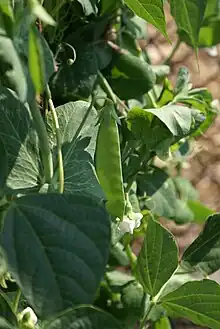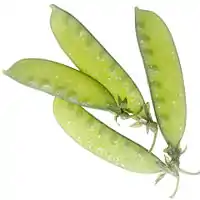Snow pea
The snow pea is an edible-pod pea with flat pods and thin pod walls.[2] It is eaten whole, with both the seeds and the pod, while still unripened.
| Snow pea | |
|---|---|
 | |
| Species | Pisum sativum |
| Cultivar group | Macrocarpon Group[1] |
| Cultivar group members | Many; see text. |
Names
The common name snow pea seems to be a misnomer as the planting season of this pea is no earlier than that of other peas. Another common name Chinese pea is probably related to its prominence in Chinese dishes served in the West.[3] It is often called mangetout ("eat-all") in the British Isles, but this can apply both to snow peas and to snap peas.
Snow peas and snap peas both belong to Macrocarpon Group,[3][4][1][5] a cultivar group based on the variety Pisum sativum var. macrocarpum Ser. named in 1825.[6] It was described as having very compressed non-leathery edible pods in the original publication.
The scientific name Pisum sativum var. saccharatum Ser. is often misused for snow peas. The variety under this name was described as having sub-leathery and compressed-terete pods and the French name petit pois.[6] The description is inconsistent with the appearance of snow peas, and therefore botanists have replaced this name with Pisum sativum var. macrocarpum.[7] Austrian scientist and monk Gregor Mendel used peas which he called Pisum saccharatum in his famous experiments demonstrating the heritable nature of specific traits, and this Latin name might not refer to the same varieties identified with modern snow peas.[8]
Composition
Nutrition
 Snow peas (Pisum sativum) | |
| Nutritional value per 100g | |
|---|---|
| Energy | 176 kJ (42 kcal) |
7.55 | |
| Sugars | 4.00 |
| Dietary fiber | 2.6 |
0.3 | |
2.8 | |
| Vitamins | Quantity %DV† |
| Vitamin A equiv. | 6% 630 μg740 μg |
| Vitamin A | 1087 IU |
| Thiamine (B1) | 13% 0.150 mg |
| Riboflavin (B2) | 7% 0.08 mg |
| Niacin (B3) | 4% 0.6 mg |
| Pantothenic acid (B5) | 15% 0.75 mg |
| Vitamin B6 | 12% 0.16 mg |
| Folate (B9) | 11% 42 μg |
| Vitamin B12 | 0% 0 μg |
| Choline | 4% 17.4 mg |
| Vitamin C | 72% 60 mg |
| Vitamin D | 0% 0 μg |
| Vitamin E | 3% 0.39 mg |
| Vitamin K | 24% 25 μg |
| Minerals | Quantity %DV† |
| Calcium | 4% 43 mg |
| Iron | 16% 2.09 mg |
| Magnesium | 7% 24 mg |
| Manganese | 12% 0.244 mg |
| Phosphorus | 8% 53 mg |
| Potassium | 4% 200 mg |
| Sodium | 0% 4 mg |
| Zinc | 3% 0.27 mg |
| Other constituents | Quantity |
| Water | 88.89 |
| |
| †Percentages are roughly approximated using US recommendations for adults. Source: USDA FoodData Central | |
Uses
Culinary
.jpg.webp)
Snow peas, along with sugar snap peas and unlike field and garden peas, are notable for having edible pods that lack inedible fiber[9] (in the form of "parchment", a fibrous layer found in the inner pod rich in lignin[10]) in the pod walls. Snow peas have the thinner walls of the two edible pod variants. Two recessive genes known as p and v are responsible for this trait.[9] p is responsible for reducing the sclerenchymatous membrane on the inner pod wall, while v reduces pod wall thickness (n is a gene that thickens pod walls in snap peas).[11]
The stems and leaves of the immature plant are used as a vegetable in Chinese cooking, stir-fried with garlic and sometimes combined with crab or other shellfish.[12]
Nitrogen fixers
As with most legumes, snow peas host beneficial bacteria, rhizobia, in their root nodules, which fix nitrogen in the soil—this is called a mutualistic relationship—and are therefore a useful companion plant, especially useful to grow intercropped with green, leafy vegetables that benefit from high nitrogen content in their soil.
Cultivation
Snow peas can be grown in open fields during cool seasons and can thus be cultivated during winter and spring seasons.[11]
Storage
Storage of the pea with films of polymethylpentene at a temperature of 5 °C and a concentration of oxygen and carbon dioxide of 5 kPa augments the shelf life, internal and external characteristics of the plant.[13]
Gallery
 Snow pea flowers
Snow pea flowers Sautéed snow pea shoots, a popular dish in Chinese cuisine
Sautéed snow pea shoots, a popular dish in Chinese cuisine
See also
References
- Stephens, James M. (2018-11-05). "Pea, Snow—Pisum sativum L. (Macrocarpon Group)". edis.ifas.ufl.edu. Retrieved 2020-02-11.
- Myers, James R.; Baggett, James R.; Lamborn, Calvin (2010-06-22), Janick, Jules (ed.), "Origin, History, and Genetic Improvement of the Snap Pea ( Pisum sativum L.)", Plant Breeding Reviews, John Wiley & Sons, Inc., pp. 93–138, doi:10.1002/9780470650196.ch3, ISBN 978-0-470-65019-6
- Kiple, Kenneth F.; Ornelas, Kriemhild Coneè (2000). The Cambridge World History of Food. Cambridge University Press. ISBN 978-0-521-40215-6.
- "Definition of SNOW PEA". www.merriam-webster.com. Retrieved 2020-02-11.
- Stephens, James M. (2018-11-05). "Pea, Snap—Pisum sativum L. (Macrocarpon Group)". edis.ifas.ufl.edu. Retrieved 2020-02-11.
- Candolle, Augustin Pyramus de (1825). Prodromus systematis naturalis regni vegetabilis, sive, Enumeratio contracta ordinum generum specierumque plantarum huc usque cognitarium, juxta methodi naturalis, normas digesta. Vol. 2. Paris, France: Sumptibus Sociorum Treuttel et Würtz. p. 368.
- "Pisum sativum var. macrocarpum". Germplasm Resources Information Network. Agricultural Research Service, United States Department of Agriculture.
- Ellis, T. H. N.; Hofer, J. M. I.; Timmerman-Vaughan, G. M.; Coyne, C. J.; Hellens, R. P. (2011). "Mendel, 150 years on". Trends in Plant Science. 16 (11): 590–596. doi:10.1016/j.tplants.2011.06.006. PMID 21775188.
- Singh RJ; Jauhar PP (2005). Genetic Resources, Chromosome Engineering, and Crop Improvement. CRC Press. pp. 74. ISBN 978-0-8493-1430-8.
- McGee, RJ; Baggett JR (1992). "Inheritance of Stringless Pod in Pisum sativum L." (PDF). J. Am. Soc. Hort. Sci. 117 (4): 628–632. doi:10.21273/JASHS.117.4.628.
- De Ron, AM; et al. (2005). "Identifying superior snow pea breeding lines" (PDF). HortScience. 40 (5): 1216–1220. doi:10.21273/HORTSCI.40.5.1216.
- "Snow Pea Shoots Photo - Chinese Vegetable Photos". Chinesefood.about.com. 2011-10-17. Archived from the original on 2014-12-28. Retrieved 2011-12-18.
- Pariasca, JAT; et al. (2001). "Effect of modified atmosphere packaging (MAP) and controlled atmosphere (CA) storage on the quality of snow pea pods (Pisum sativum L. var. saccharatum)". Postharvest Biology and Technology. 21 (2): 213–223. doi:10.1016/S0925-5214(00)00149-6.